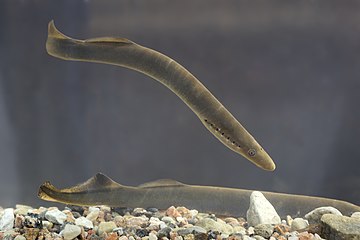Nine Eyed Lompers
- Posted in:
- NewsletterArchive
This fantastic article comes from our Spring 2000 Heritage Newsletter:
When King John died in Newark Castle in 1216, the cause was believed to have been his overindulgence in a favourite food – lampreys. He was not the only king to have enjoyed the dish, Henry I reputedly died of a ‘surfeit of lampreys’ in 1135. Lampreys were a Medieval delicacy. The ones on which John feasted will have come from the river Trent, one of the few places in the country where they could be caught in abundance. They remained a Nottinghamshire delicacy for centuries but are now little known.
The lamprey looks like an eel. Its mouth is a round sucker. It has one nostril on the top of its head, seven round gills on either side of its head, and a pair of eyes. The gills and nostril when viewed from the side look like eyes, hence the creature’s Nottinghamshire name of the ‘nine eyed lomper’.
Two species of lamprey may be found in the Trent, the river lamprey which grows to about 30cm long, and the brook lamprey, shorter at 15cm. The river lamprey is a parasite of freshwater fish on to which it hooks with its strong sucker-like mouth and ring of sharp teeth. It will also feed on carrion. The adult brook lamprey does not feed at all. Anglers rarely notice the fish because they are not often caught with rod and line. Traditionally, the lampreys were netted or caught in baskets during their spring migration up stream where they went to spawn and then die. The weir at Averham was a favourite place for catching the lampreys, and sometimes they may be spotted there, hanging on to stones with the suckers of their mouths, tails streaming like a ribbon in the current.
While the deaths of both kings were ascribed at the time to their excessive fondness for the fish, other reasons are possible. Henry I was 67 when he died, old by the standards of the time. Only a few days before John reached Newark, he suffered the disastrous loss of his baggage train whilst travelling across the Wash, and his death may be a consequence of this accident. However, the specific mention of lampreys suggests that both kings had been presented with the delicacy shortly before they died. Lampreys live in unpolluted water. Where they are taken from polluted rivers, they can carry harmful bacteria. Could the Medieval fishermen of Newark have prepared a treat for the king, only to inadvertently kill him with food poisoning?

Above: River lamprey (By Tiit Hunt - Own work, CC BY-SA 3.0).
Lampreys can be prepared in a number of different ways; stewed, potted, or baked into pies, but frying makes them tough and chewy. They may be treated as eels. Here is a recipe to try;
Lamprey Pie:
- 1-2 Lampreys
- 150g Lincolnshire sausage meat
- Salt and Pepper
- Packet puff pastry
- Juice of a lemon
- Parsley
- Nutmeg
- 1 shallot, finely chopped
- 200ml Bechamel Sauce
Cut the lampreys into pieces 5cm long. Line an oven proof dish with half of the puff pastry. Cover the bottom of the dish with the sausage meat. Cover with the lampreys. Add a pinch of salt, pepper, a little nutmeg, the shallot, lemon juice and a good sprinkling of chopped fresh parsley. Cover the pie with the rest of the pastry and bake until the top has risen and pale golden. Remove from the oven and through the vent pour the Bechamel sauce. Return to the oven for 5-10 minutes. Serve immediately.
Whatever the truth behind the mystery of John’s death, this is certainly a dish fit for a king!
